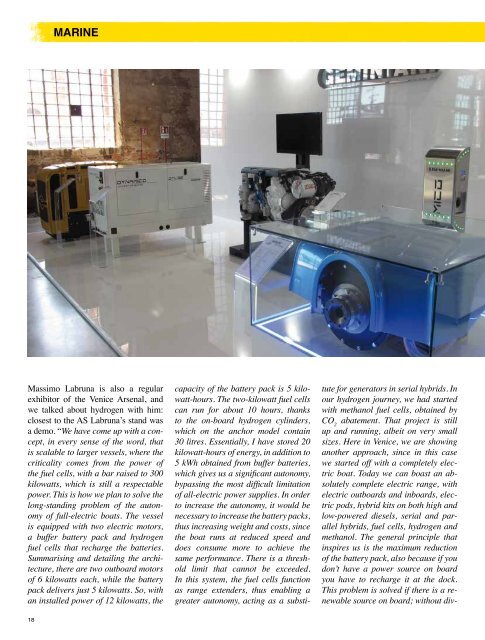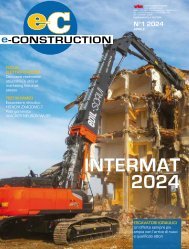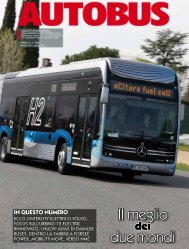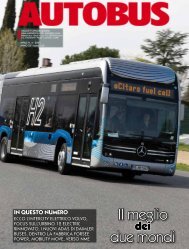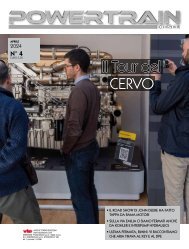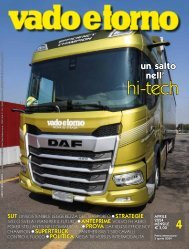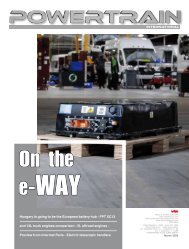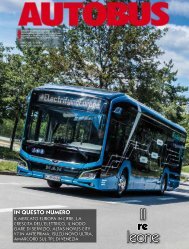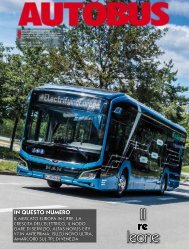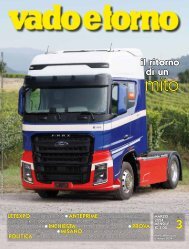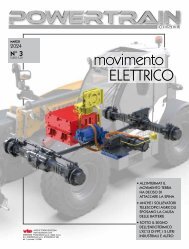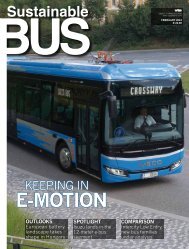Powertrain | Diesel International 2022-09
EMISSIONS CUMMINS: How to reduce consumption POWER GENERATION ROLLS-ROYCE POWER SYSTEMS: Symposium, where to experience the future EXHIBITIONS VENICE BOAT SHOW: Electric, hydrogen, diesel, LPG INTERVIEWS FPT INDUSTRIAL: Growing fast in the US and China ENGINES MAN ENGINES: Dual fuel hydrogen-engines (and V12X 2200hp) OFF-SHORE: OXE and Cox “run” diesel SCANIA: An orange mermaid at the Genoa Boat Show WÄRTSILÄ: Sustainable Technology Hub VOLVO PENTA: IMO Tier III D13 for work boats BOATS FISH-EYE: Yanmar to power Lyman-Morse Hood 35LM GERRISBOATS: A disruptive hull for electric tenders ALTERNATIVE FUELS CHEVRON: Global Centre for Maritime Decarbonisation THINK PINK UNIVERSITY OF COVENTRY: Lorena Moreira is a brilliant young engineer COLUMNS Editorial; Newsroom; Automotive; Techno
EMISSIONS
CUMMINS: How to reduce consumption
POWER GENERATION
ROLLS-ROYCE POWER SYSTEMS: Symposium, where to experience the future
EXHIBITIONS
VENICE BOAT SHOW: Electric, hydrogen, diesel, LPG
INTERVIEWS
FPT INDUSTRIAL: Growing fast in the US and China
ENGINES
MAN ENGINES: Dual fuel hydrogen-engines (and V12X 2200hp)
OFF-SHORE: OXE and Cox “run” diesel
SCANIA: An orange mermaid at the Genoa Boat Show
WÄRTSILÄ: Sustainable Technology Hub
VOLVO PENTA: IMO Tier III D13 for work boats
BOATS
FISH-EYE: Yanmar to power Lyman-Morse Hood 35LM
GERRISBOATS: A disruptive hull for electric tenders
ALTERNATIVE FUELS
CHEVRON: Global Centre for Maritime Decarbonisation
THINK PINK
UNIVERSITY OF COVENTRY: Lorena Moreira is a brilliant young engineer
COLUMNS
Editorial; Newsroom; Automotive; Techno
Create successful ePaper yourself
Turn your PDF publications into a flip-book with our unique Google optimized e-Paper software.
MARINE<br />
#GEMINIANI #ASLABRUNA #AUTOGAS<br />
Massimo Labruna is also a regular<br />
exhibitor of the Venice Arsenal, and<br />
we talked about hydrogen with him:<br />
closest to the AS Labruna’s stand was<br />
a demo. “We have come up with a concept,<br />
in every sense of the word, that<br />
is scalable to larger vessels, where the<br />
criticality comes from the power of<br />
the fuel cells, with a bar raised to 300<br />
kilowatts, which is still a respectable<br />
power. This is how we plan to solve the<br />
long-standing problem of the autonomy<br />
of full-electric boats. The vessel<br />
is equipped with two electric motors,<br />
a buffer battery pack and hydrogen<br />
fuel cells that recharge the batteries.<br />
Summarising and detailing the architecture,<br />
there are two outboard motors<br />
of 6 kilowatts each, while the battery<br />
pack delivers just 5 kilowatts. So, with<br />
an installed power of 12 kilowatts, the<br />
tute for generators in serial hybrids. In<br />
our hydrogen journey, we had started<br />
with methanol fuel cells, obtained by<br />
CO 2<br />
abatement. That project is still<br />
up and running, albeit on very small<br />
sizes. Here in Venice, we are showing<br />
another approach, since in this case<br />
we started off with a completely electric<br />
boat. Today we can boast an absolutely<br />
complete electric range, with<br />
electric outboards and inboards, electric<br />
pods, hybrid kits on both high and<br />
low-powered diesels, serial and parallel<br />
hybrids, fuel cells, hydrogen and<br />
methanol. The general principle that<br />
inspires us is the maximum reduction<br />
of the battery pack, also because if you<br />
don’t have a power source on board<br />
you have to recharge it at the dock.<br />
This problem is solved if there is a renewable<br />
source on board; without divcapacity<br />
of the battery pack is 5 kilowatt-hours.<br />
The two-kilowatt fuel cells<br />
can run for about 10 hours, thanks<br />
to the on-board hydrogen cylinders,<br />
which on the anchor model contain<br />
30 litres. Essentially, I have stored 20<br />
kilowatt-hours of energy, in addition to<br />
5 kWh obtained from buffer batteries,<br />
which gives us a significant autonomy,<br />
bypassing the most difficult limitation<br />
of all-electric power supplies. In order<br />
to increase the autonomy, it would be<br />
necessary to increase the battery packs,<br />
thus increasing weight and costs, since<br />
the boat runs at reduced speed and<br />
does consume more to achieve the<br />
same performance. There is a threshold<br />
limit that cannot be exceeded.<br />
In this system, the fuel cells function<br />
as range extenders, thus enabling a<br />
greater autonomy, acting as a substi-<br />
ing into waters, this is an issue concerning<br />
any application, even cars.<br />
In order to store energy, the battery<br />
needs a long recharge time, unlike the<br />
hydrogen cylinder or methanol tank”.<br />
Also at the AS Lavruna stand was<br />
CMD’s BlueHybrid system, equipped<br />
with a hybrid control unit, which controls<br />
both the endothermic engine and<br />
the electric motor and communicates<br />
with the GPS signal, so that it automatically<br />
converts the navigation to<br />
the electric mode.<br />
In 2021 Autogas, acquired by Ecomotive<br />
Solutions, broke the threshold of<br />
3,000 bifuel petrol/LPG conversions<br />
on vessels. At the time, they told us of<br />
a detail that is also suitable for lagoons<br />
and bays at these latitudes (Venice,<br />
Scardovari, Marano, Grado), namely<br />
the “particular and specific use in<br />
large fishing farms, where, for moving<br />
between breeding basins, the use<br />
of vessels with LPG-powered engines<br />
contributes to maintaining clean waters<br />
for a more valuable and higher<br />
quality catch.” So, the gazebo of Autogas,<br />
owned by Ecomotive Solutions,<br />
could not be missing. They confirm<br />
us that they are there to incentivise the<br />
retrofitting system of outboard/inboard<br />
petrol-powered vessels that have been<br />
fully converted to LPG. The kits, which<br />
are definitely inexpensive, comply with<br />
the regulations drawn up by the Ministry<br />
of Transports, and are available<br />
both with fixed on-board cylinders and<br />
with transportable cylinders, which are<br />
specially constructed following the automotive<br />
logic, to facilitate refuelling.<br />
Generally, a transportable cylinder cannot<br />
be refuelled at the station because it<br />
has no level and “overflow” indicator,<br />
i.e. it does not stop at 80 percent of its<br />
capacity. This one, on the contrary, has<br />
the same automatic system as a car so,<br />
once it gets to 80 percent, it stops refuelling.<br />
Plus, there is a quick coupling,<br />
clearly designed for boats compatible<br />
with this storage, which is 30 litres.<br />
They tell us of “a 75-litre version that<br />
allows for 8/9 hours of autonomy with<br />
a 60-horsepower outboard engine. The<br />
Venetians are showing interest in this<br />
system. In terms of costs, such conversion<br />
would be around 2,500 euros. We<br />
just did a quick calculation with the<br />
owner of a boat with inboard engine<br />
equipped with two 200-horsepower engines.<br />
By putting 200 litres of LPG on<br />
board, it would cost him around 5,000<br />
euros. And on a boat that consumes 60<br />
litres/hour of petrol...”<br />
18<br />
19


